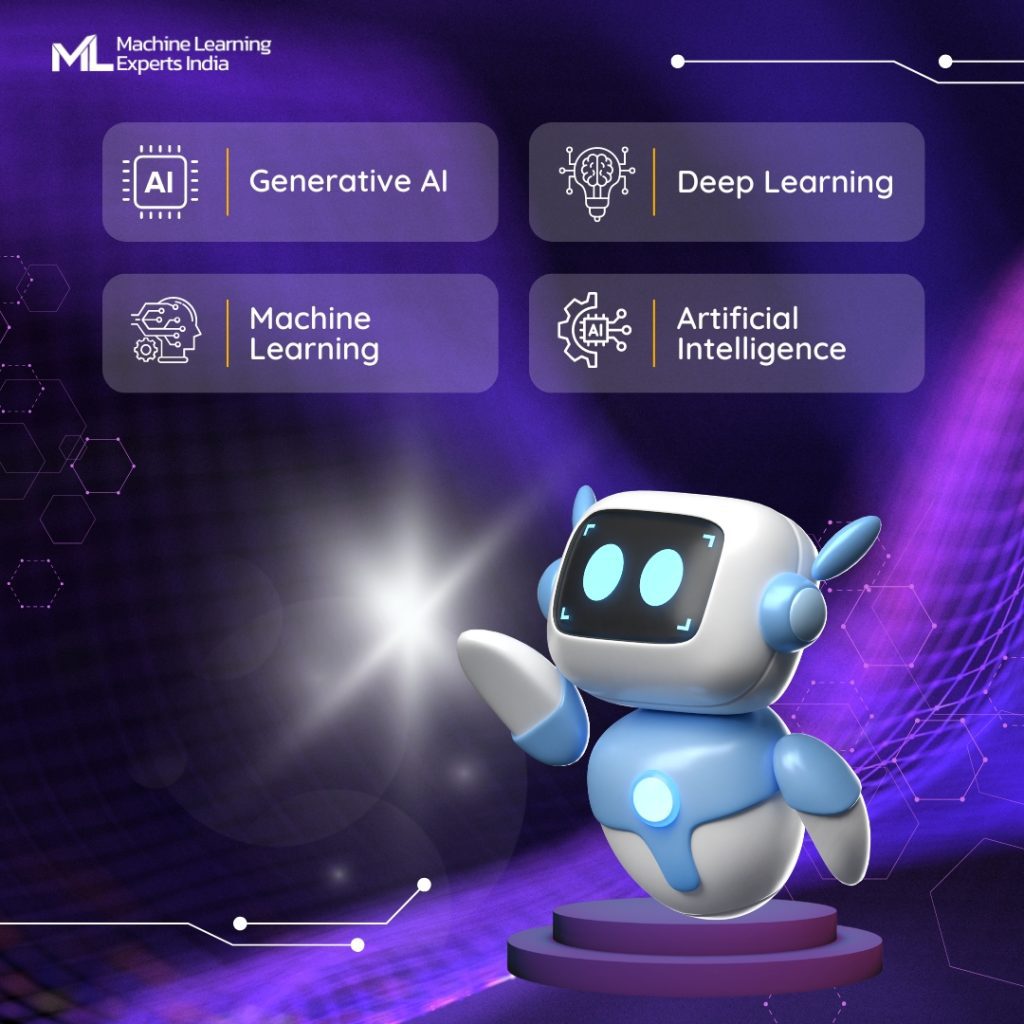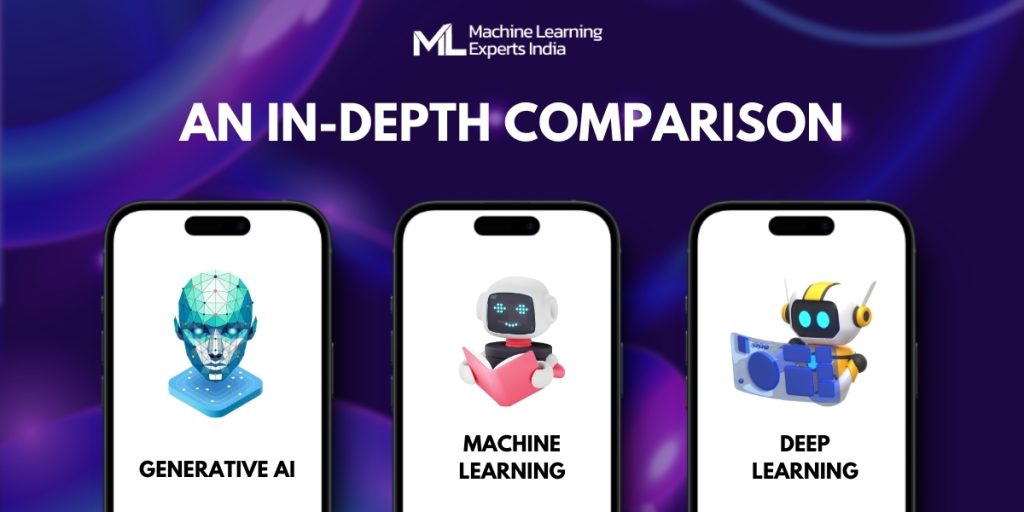Machine Learning vs Deep Learning vs Generative AI: Unravel The Future of AI
Are you leaving behind in the race while competing in this technology-laden era? Do you ever think about what you are not and what everyone else is doing to march forward in the way toward success? It is all about diving deep into the stream filled with technologies. Technology is becoming more and more embedded in our daily lives and altering our way of thinking and dealing with things. Some crucial ones are AI, Generative AI, Machine Learning, and Deep Learning Services. To know what it can bring for you vividly, understand the difference between generative AI vs Machine Learning vs Deep learning. Beginning from the start i.e., Artificial Intelligence to grave this flow in your mind.
The confusion that might prevail in your mind as soon as you step forward to merge such technologies with your business is that these all will seem identical to you. To eradicate such kind of dilemma, dig into this blog till the end.
So, let’s begin now!
Generative AI vs Machine Learning vs Deep Learning: Origin From AI As Their Foundation

While Deep Learning, Machine learning, and Generative AI may sound similar, they all differ in various ways. They perhaps sometimes get used up interchangeably thus making the need to peek into Generative AI vs Machine Learning vs Deep Learning. The interesting thing is that it all comes under one roof i.e., the umbrella of Artificial Intelligence. Thus, everything called deep learning or machine learning will surely come under Artificial Intelligence but it is not the case that everything described as machine learning will not be identical to Deep learning.
AI As A Whole Segment
AI is completely a field of computer science that deals with developing intelligent machines that can think and advance like humans. AI systems are based on algorithms that can perform tasks that need human intelligence.
Before jumping into Machine Learning vs Deep learning, you must understand how these technologies emerge from one another and what impact they can make with their usage.
Machine Learning As A Subset of Artificial Intelligence
Machine learning is exactly a subset of AI focused on building systems that can learn from data without being detailed programmed. Besides this, it learns from large datasets and learns from the patterns it leverages. Machine learning can be further divided into three sub-categories that are: Supervised learning, Unsupervised learning, and reinforcement learning.
Deep Learning as a parent category of Machine learning
Deep learning is a crucial subset of machine learning focused on building artificial neural networks that can learn from data. Neural networks are crafted specially to mimic the structure of the human brain and deep learning networks have several layers of neurons that can recognize and inspect the complex patterns in the data sets.
The main usage of deep learning can be seen through its impact on the field of computer vision letting machines identify objects and images with full precision.
Generative AI As A Sub-Segment of Deep Learning
Generative AI is a widely accepted subset of deep learning that generally focuses on building systems that can lead to generating images, videos, and audio. Generative AI takes the usage of technologies involving Generative Adversarial Networks (GANs) and Variational Autoencoders (VAEs) to form fresh data by learning from existing data.
This technology having its branches to AI has many applications like forming engaging images, generating unique texts, and even sometimes creating new music. It can bring transformation no matter what the industry is.
Generative AI vs Machine Learning Vs Deep Learning: An In-Depth Comparison

It is time for you to erase your confusion in understanding what are all these technologies and how they are different from each other even when they originate from the same point i.e., Artificial Intelligence. Take a look at this table to learn about the detailed comparison between Generative AI vs Machine Learning vs Deep Learning.
| Criteria | Generative AI | Machine Learning | Deep Learning |
| Explanation | Generative AI is all about capable of forming data quite identical to the existing one | It is a subset of Artificial Intelligence mainly dependent on learning from data | A subset of Machine learning that advances through neural networks |
| General use cases | Primary usage is for image & video generation, text generation, & art creation | Used Mainly for predictive analysis, suggestion systems, and segregation | Image & speech recognition, natural language processing, and for autonomous driving |
| Merits | Tilted more toward the creative side can generate realistic data and elevate the training datasets | In machine learning vs deep learning, the first one carries the flexibility to solve a wide array of tasks and can refine itself with more data | Deep learning has unmatched accuracy in complex tasks, the ability to improve from raw data, automatic feature extraction |
| Pivotal techniques | It is both GANs (Generative Adversarial networks) and VAEs (Variational Autoencoders) | Three are here i.e., Supervised learning, unsupervised learning, and reinforcement learning | Convolutional Neural Networks (CNNs), Recurrent Neural Networks (RNNs), & Deep Belief Networks (DBNs) |
| Restrictions | In AI vs Generative AI, the latter is poised to distort the quality of generative data, demand large amounts of data, and computationally intensive | Posed need for quality data & feature engineering, and potentially overfitting sometimes | Need vast amounts of computational resources and data, and can prove to be a black box in terms of interpretability |
| Use cases of Each | Forming up synthetic images for training, and creation of realistic video game characters, and text-to-speech recognition | Spam identification, customer segregation, and stock market prediction | Includes facial spotting systems, language translation, self-driving cars |
| Role in AI | Take up the level of creativity and content generation and can assist effortlessly other AI models with synthetic data | Machine learning acts as a fundamental block for most AI applications, letting others for predictive and prescriptive analysis | Reason for advancements in complex AI tasks, powers breakthroughs in perception-based tasks |
| Learning procedure | Learns to create new data by mimicking existing patterns in the current data | Learns and takes into consideration patterns and relationships from labeled or unlabeled data | Learns hierarchical features from large datasets through deep neural networks |
Even after this table of comparison between Generative AI vs Machine Learning vs Deep Learning, some people might find themselves stuck in a dilemma because of the name i.e., Machine Learning and Deep Learning and in between AI and Generative AI. Their mind might be thinking how these are different from each other and if not then why there is so much segregation.
Thus, for them, here in the next section, the light will be on Machine Learning vs Deep Learning followed by AI vs Generative AI.
Machine Learning vs Deep Learning: How does the first one differ from the other?
Based on the explanation given above, it is quite clear that deep learning is a subset of machine learning. The main difference between both these is how each algorithm learns to advance and how much data one of these algorithms uses.
Firstly, Deep Learning automates much of the task of feature extraction segments of the process, kicking out the need for manual intervention. It also enables the usage of large data sets, receiving the title of scalable machine learning. This capability is quite promising and showcases a bright future when we jump on to explore the boundaries of unstructured data. It is necessary as almost 80% of the organization’s data is estimated to be unstructured and intermingled.
Inspecting patterns in the collected data allows the deep learning model to lay out inputs appropriately. A deep learning model requires more data points to elevate the bar of accuracy whereas a machine learning model relies more on less data along with the data structure. Enterprises generally tilt towards the usage of deep learning to tackle most of the complex tasks like virtual assistants or fraud detection.
AI vs Generative AI: A Step To Eradicate Doubts
All the traditional AI and its modern counterparts are known for analyzing the entire volume of existing data, but Generative AI took a fundamentally different approach. It has a backup of large language models (LLMs) that can contextualize huge volumes of data and create natural language responses. Generative AI refined a lot and now developed its ability to not only identify patterns but can form new and original content right from scratch.
This Generative AI opens up new possibilities for hyper-automation, innovation, and customization in the segment of R&D, customer service, and so on.
Ending Note!
Right next to a dive into Generative AI vs Machine Learning vs Deep Learning, there is nothing wrong with saying that every tech is different from the other and each has its specific use cases in the real world. These are undoubtedly bringing a revolution in the industries or technology-laden paradigm and changing our way completely of engaging with life and work. It will not end here as AI is continuing to evolve every day. Certainly, a lot more advancement will indeed make their way in the future and take us away in the new paradigm shift.
Eager to Hold Potential of Tech Aside Machine Learning vs Deep Learning? Machine Learning Experts is the place for you to come! Let us unleash the true power of these technologies for you and have your back every step of the way.


